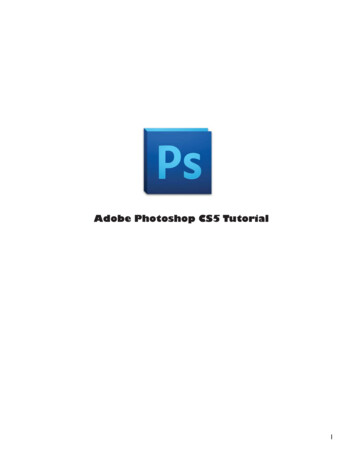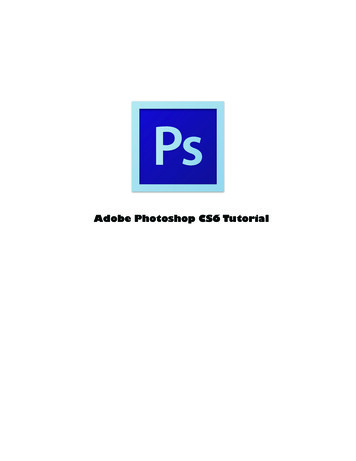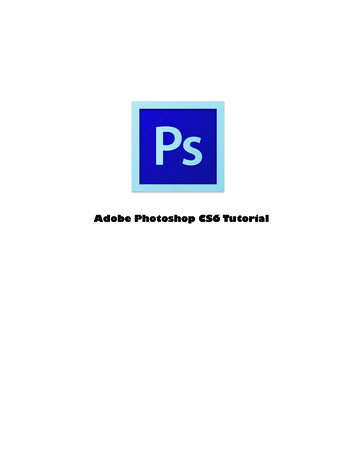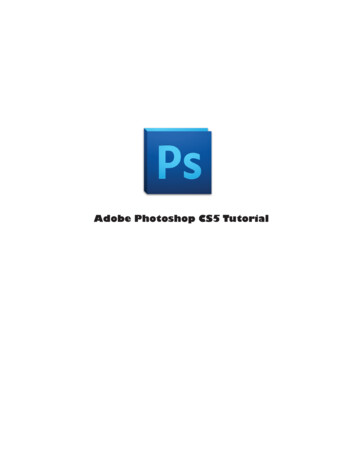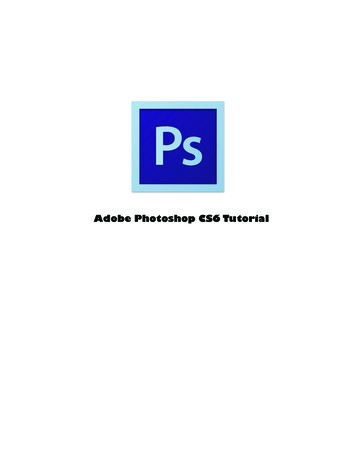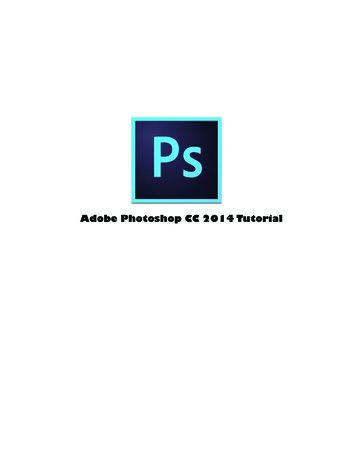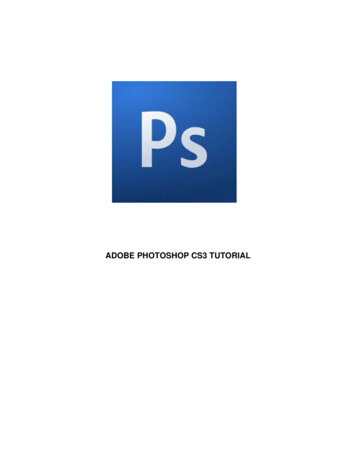
Transcription
ADOBE PHOTOSHOP CS3 TUTORIAL
ADOBE PHOTOSHOP CS3Adobe Photoshop CS3 is a popular image editing software that provides a workenvironment consistent with Adobe Illustrator, Adobe InDesign, Adobe ImageReady, andother products in the Adobe Creative Suite. This tutorial is an introduction to usingAdobe Photoshop. Here you will learn how to get started, how to use the interface, andhow to modify images with basic Photoshop tools.TABLE OF CONTENTSSection 1: Getting StartedPg. 3Section 2: Interface LayoutPg. 6Section 3: PalettesPg. 7Section 4: ToolboxPg. 11Section 5: Selection ToolsPg. 13Section 6: Alteration ToolsPg. 15Section 7: Drawing and Selection ToolsPg. 17Section 8: Assisting ToolsPg. 18Section 9: Color Boxes and ModesPg. 19Section 10: Basic Image EditingPg. 20Section 11: CroppingPg. 21Section 12: ResizingPg. 25Section 13: CorrectingPg. 29Section 14: Sharpening/SofteningPg. 35Section 15: SavingPg. 37Adobe Photoshop CS32
GETTING STARTEDOPENINGBegin by opening Adobe Photoshop CS3.On a PC, click Start Programs Adobe Photoshop CS3, or click on the shortcuton the desktop.On a Mac, click Macintosh HD Applications Adobe Photoshop CS3 Photoshop CS3 shown in Figure 1, or click the icon in the Dock.Fig. 1. Navigation to Photoshop CS3 on a MacSETTING UP THE DOCUMENTSetting up your document correctly from the start will make your job much easier as youwork through your project. This will require some advanced planning. For example, ifyour final output will be a brochure, you may need to set up your document to behorizontal and double-sided.To create a new document, click File New. This will open the Document Setup dialogbox (Fig. 2).Adobe Photoshop CS33
Fig. 2. Document Setup dialog boxHere you will be able to name your file, set up the correct page size, and orientation foryour document. Options include, but are not limited to:Page Size and OrientationChange the page size by typing in new values for width and height. Page sizerepresents the final size you want after bleeds or trimming other marks outside the page.In the Preset dropdown menu you can find such common sizes as letter, legal, tabloid,etc. Typing in exact values for Height and Width gives you more control over the sizeand orientation of your page.ResolutionResolution is a number of pixels on a printed area of an image. The higher theresolution, the more pixels there are on the page, the better is the quality of the image.However, high resolution increases the size of the file. The standard recommendedresolution for printed images is 150 - 300, for Web images - 72.Color ModeChoose a color mode that will best fit your project. For example, when making a graphicfor a web site, choose RGB. When making an image for print, choose CMYK.Background ContentsChoose the background: white, color, or transparent.When you have entered all of your document settings, click OK.Adobe Photoshop CS34
OPENING AN IMAGE FROM A DISKIf the image you have is saved on a disk, select File Open, and then navigate to thedisk drive where your image is saved. Choose the image file and click Open. At thispoint, you may want to save your image under a different name so that you can alwayshave the original to fall back on in case of a mistake. To save you r file, select File Save As and type in the new name of the file in the dialogue box. Now you should beready to go.Adobe Photoshop CS35
INTERFACE LAYOUTThis is the layout of Adobe Photoshop interface.Menu BarIf you look at the top of the screen you will see the Menu bar which contains all the mainfunctions of Photoshop, such as File, Edit, Image, Layer, Select, Filter, View,Window, and Help.Tool BarMost of the major tools are located in the Tool bar for easy access.The ImageThe image will appear in its own window once you open a file.Image NameThe name of any image that you open will be at the top of the image window as shownabove.PalettesPalettes contain functions that help you monitor and modify images. By default, palettesare stacked together in groups. These are the palettes that are usually visible:Navigator, Color, Histogram, Layer. If none of the palettes are visible, go to Windowin the Menu bar and choose palettes you need to work with.Adobe Photoshop CS36
PALETTESBelow is the description of the most commonly used palettes in Adobe Photoshop CS3.Palettes used for more advanced image editing will be covered in the Adobe PhotoshopCS3 Tutorial - Intermediate.NAVIGATORThe Navigator palette (Fig. 1) allows you to resize and move around within the image.Drag the slider, click on the Zoom In and Zoom Out icons, or specify the percentage tonavigate in the image.Fig. 1. Navigator paletteCOLOR, SWATCHES, STYLEThe Color palette (Fig. 2) displays the current foreground and background colors andRGB values for these colors. You can use the sliders to change the foreground andbackground colors in different color modes. You can also choose a color from thespectrum of colors displayed in the color ramp at the bottom of the palette.Fig. 2. Color paletteIn the Swatches palette (Fig. 3) you can choose a foreground or background color oradd a customized color to the library.Adobe Photoshop CS37
Fig. 3. Swatches paletteThe Styles palette (Fig. 4) allows you to view, select, and apply preset layer styles. Bydefault, a preset style replaces the current layer style. You can use the styles in thepalette or add your own using the Create New Style icon.Figure 4. Styles paletteHISTORYThe History palette (Fig. 5) stores and displays each action performed allowing youjump to any recent stage of the image alteration. The alterations should be createdduring the current working session; after saving or closing the document the Historypalette clears all the contents. Each time you apply a change to an image, the new stateof that image is added to the palette. The History palette can store up to 20 stages.However, you can always go back to the first stage, for example opening the document.It is important to know that once you click on any of the previous stages, all the changesthat were made after it will be lost.Adobe Photoshop CS38
Fig. 5. History paletteLAYERSLayers let you organize your work into distinct levels that can be edited and viewed asindividual units. Every Photoshop CS3 document contains at least one layer. Creatingmultiple layers lets you easily control how your artwork is printed, displayed, and edited.You will use the Layers palette (Fig. 6) often while creating a document, so it is crucialto understand what it does and how to use it.A) Layer Visibility - The eye shows that theselected layer is visible. Click on or off to see orto hide a layer.B) Layer Locking Options - Click thecheckered square icon to lock Transparency;click the brush icon to lock the Image; click thearrow icon to lock the Position; click the lockicon to lock all options.C) Layer Blending Mode - Defines how thelayer's pixels blend with underlying pixels in theimage. By choosing a particular blending modefrom the dropdown menu you can create avariety of special effects.D) Fill - By typing in a value or dragging theslider you can specify the transparency of theAdobe Photoshop CS39
Fig. 6. Layers Palettecolor of the image or object.E) Opacity - By typing in a value or dragging aslider you can specify the transparency of theentire layer.F) Layer Lock - The icon shows when the layeris locked and disappears when it is unlocked.Double-click the icon to unlock the layer.G) Layer Options Menu - Click the blacktriangle to see the following options: New Layer,Duplicate Layer, Delete Layer, LayerProperties, etc. Some of the options arepresented as icons at the bottom of the Layerspalette.H) Link Layers – Can be used to link layerstogether.I) Layer Styles - If a layer has a style, an "F"icon shows at the bottom of the Layers palette.Click the little black triangle to see style options.J) Layer Mask - A grayscale image, with partspainted in black hidden, parts painted in whiteshowing, and parts painted in gray shadesshowing in various levels of transparency.K) Layer Set - This option helps to organizeimages with multiple layers. Click the icon tocreate a folder for several layers.L) Create New Fill or Adjustment Layer - Havethe same opacity and blending mode options asimage layers and can be rearranged, deleted,hidden, and duplicated in the same manner asimage layers. Click the icon and select an optionto create a new fill or adjustment layer.M) Create New Layer - Click this icon to createa new layer.N) Delete Layer - To delete a layer, select alayer in the Layers palette and drag it to thetrash can icon; or, select a layer and click theicon.Adobe Photoshop CS3 10
TOOLBOXIf you used other Adobe products, such as Illustrator or InDesign, you should be familiarwith the toolbox in Photoshop CS3 as it shares some of the tools from theseapplications. If you are a novice user of Adobe products, you should keep in mind thatyou might not need to use all of the tools. In this tutorial, only the basic tools will bediscussed in depth.Adobe Photoshop CS3 11
Some tools in the toolbar have additional "hidden" tools. These tools have small blacktriangles in the right-hand corner. To view the "hidden" tools, click and hold down on anytool that has a black triangle in the corner (Fig. 1).Fig. 1. "Hidden" toolsAdobe Photoshop CS3 12
SELECTION TOOLSBUTTONTOOLMarqueeDESCRIPTIONSelects an object by drawing a rectangle or an ellipse aroundit.Click the tool button, choose a rectangular or an ellipticalmarquee. Drag the marquee over the area of the image youwish to select.MoveUsed to select and move objects on the page.Click the tool button, then click on any object on the page youwish to move.LassoSelects an object by drawing a freehand border around it.Click the tool button, drag to draw a freehand border aroundthe are of the image you wish to select.PolygonalLassoSelects an object by drawing a straight-edge border around it.Click the tool button, click on the starting point on the image,drag to draw a straight-edge border, click and drag again toselect the are of the image you wish to select. Double-click tofinish.MagneticLassoSelects an object by drawing a border that snaps to the edgesof the defined area of the object.Click on the starting point on the image, drag around the are ofthe image. The tool will make fastening points at the edges. Tofinish selecting, drag the border to the starting point and clickprecisely in the point.MagicWandSelects all objects in a document with the same or similar fillcolor, stroke weight, stroke color, opacity, or blending mode.By specifying the color range, or tolerance, you can controlwhat the Magic Wand tool selects.Click the tool button, then click on the area of the image youwish to select.Crop ToolSelects and cuts parts of an image.Click the tool button, then click and drag the tool over the partof the image that you want to keep. Resize the selected areadragging the squares at the sides and corners. Click theRETURN key when your crop box is sized correctly.Adobe Photoshop CS3 13
Slice ToolUsed to cut images into slices, which can be exported to a webpage.Adobe Photoshop CS3 14
ALTERATION TOOLSBUTTONTOOLHealingBrushDESCRIPTIONCorrects small blemishes in scanned photos.Select the tool, hold down the ALT key and left-click on thebase color you need to heal. Then left-click over theblemish.Brush ToolDraws lines of different thicknesses and colors.Select the tool. Then click on the selected area, drag todraw lines. Use the Options bar to change the Brush,Mode, Opacity, and Flow.Clone StampTakes a sample of an image and applies over anotherimage, or a part of the same image.Select the tool. Hold down the ALT key and left-click on acertain point of the document where you want to start yourcopy point. Then, put your mouse over whatever part of thenew document you want the picture to go to. Hold downthe left mouse button and drag the mouse across the pageto copy the picture.Art HistoryBrushPaints over an image using the source data from aspecified history state or snapshot.Select the tool, specify the Brush, Blending Mode,Opacity, Style, Area, and Tolerance.Erase ToolRemoves part of an existing path or stroke. You can usethe Erase tool on paths, but not on text.Select the tool, click on the part of the image you wish toerase. Drag to erase pixels.Paint BucketToolFills and entire area with a specific color of your choice.Select the tool. Choose a foreground color in the ColorBox. Select an area you wish to apply the color to. Clickthe tool button, then click on the selected area.Gradient ToolApplies a gradient fill to a selected part of the image or toan entire layer.Select an area you wish to apply gradient to, click the toolbutton, choose a fill in the Options bar, click on the startingpoint, hold the mouse down and drag to the end point.Adobe Photoshop CS3 15
Blur ToolBlurs the sharp edges of an image.Select an area where you wish to apply the tool. Click thetool button, choose the Brush, Mode, and Strength. Dragthe brush along the edges.Dodge ToolLightens areas in an image.Select the area where you wish to apply the tool. Choosethe Brush, Range, and Exposure. Click on the spots youwish to highlight.Adobe Photoshop CS3 16
DRAWING AND SELECTION ts paths and path segments.Type ToolTypes text on a page. Every time you click the Type Toolon a new portion of the page a new layer will be created.Select the tool, click anywhere on the path.Select the tool, click on the page and begin to type. Youcan specify the font and size in the Options bar. You canalso resize and transform the text box by dragging thesquares at the sides and corners. Use the Move Tool tomove the text on the page.Pen ToolDraws smooth-edged paths.Select the tool, click on the page, drag to draw a path.Click and drag the anchor points to modify the path.RectangleToolDraws a rectangle shape. Other shapes that are hidden inthis tool are: Rounded Rectangle Tool, Ellipse Tool,Polygon Tool, Line Tool, and Custom Shape Tool.Select the tool, click and drag on the page to draw ashape. The shape will be automatically filled with thecurrent foreground color.Adobe Photoshop CS3 17
ASSISTING TOOLSBUTTONTOOLNotes ToolDESCRIPTIONServes as a comment feature. Usually used for electronictext edits.Select the tool, click on the spot on the page where youwish to make a comment. Type in the text box.EyedropperToolTakes color samples from colors on the page and displaysthem in the Color Boxes.Select the tool, click on the color in the image you wish tosample. The Color Box will display this color.Hand ToolAllows you to move around within the image.Select the tool, click on the spot on the page, hold themouse button down, drag to move in the area.MagnifyingGlass ToolMagnifies or reduces the display of any area in your imagewindow.Select the tool, choose Zoom In or Zoom Out in theOptions bar, click on the area of the image you wish tomagnify or reduce.Adobe Photoshop CS3 18
COLOR BOXES AND MODESBUTTONTOOLDESCRIPTIONColor BoxesThe foreground color appears in the upper color selectionbox and represents a color that is currently active. Thebackground color appears in the lower box and representsan inactive color.To change the foreground color, click the upper colorselection box in the toolbox.To change the background color, click the lower colorselection box in the toolbox.To reverse the foreground and background colors, click theSwitch Colors icon (the arrow) in the toolbox.To restore the default foreground and background colors,click the Default Colors icon (the little black and whiteboxes) in the toolbox.NOTE: If you are using the Gradient Tool, the currentlyselected foreground and background colors will be thedefault colors of the gradient.ModesEdit in Standard Mode and Edit in Quick Mask Modeare used for modifying images in the unmasked or maskedarea.Standard Screen, Full Screen with Menu Bar, FullScreen are used for viewing larger or smaller are of theimage.Edit in ImageReady is used to transfer the file for editingin Adobe ImageReady.Adobe Photoshop CS3 19
BASIC IMAGE EDITINGNow that you know how to find your way around in the Photoshop interface and arefamiliar with the most common commands, pallets, and tools, you can start doing somebasic image editing. In the next few chapters of this tutorial you will learn how to crop,resize, correct, and sharp/blur your images.Adobe Photoshop CS3 20
CROPPINGCropping is one of the most basic editing techniques that can improve your images.Cropping helps to bring out the most important features in your image and focus theviewers' attention on these features. Cropping also allows you to make your image astandard photo size.There are several ways to crop images in Adobe Photoshop:1. Cropping with the Crop Tool2. Cropping to a specific size3. Cropping with the Marquee ToolCROPPING WITH THE CROP TOOLThe Crop Tool allows you to make a precise selection of an image you wish to edit. Tocrop with the Crop Tool, follow these steps:1. Open the image you wish to crop (see Getting Started for detailed instructions).2. Select the Crop Tool from the Toolbox (see Selection Tools for location anddescription).3. Click on your image once and drag the mouse out to make a cropping border (Fig. 1).Fig. 1. Cropping borderAdobe Photoshop CS3 21
4. Resize the border by dragging the squares at the sides and corners till you aresatisfied with the way your image looks.NOTE: You can also rotate your cropping border. Move the cursor outside the border,you will see how it turns into a double-headed arrow (Fig. 2). Drag the arrows in thedirections you wish to rotate your selection.Fig. 2. Rotating the cropping border5. Once you are completely satisfied with your cropped image, press ENTER.CROPPING TO A SPECIFIC SIZEIf you wish to print your digital photos or other images on standard size photo paper, youwill have to crop your images to a specific size, such as 8x10. To crop an image to aspecific size, do the following:1. Open the image you wish to crop.2. Select the Crop Tool from the Toolbox.3. In the Options bar, specify the values for Width and Height (Fig. 3).Fig. 3. Crop Tool Options bar4. Click in your image and drag the cropping border. Notice that the border isconstrained - you cannot make it wider or longer than the specified values (Figure 4).For example, if you entered 8 for Width and 10 for Height, whatever size you make theborder, the area within it will fit on an 8x10 photo.Adobe Photoshop CS3 22
Fig. 4. Cropping to a specific size5. Once you are completely satisfied with your cropped image, press ENTER.CROPPING WITH THE MARQUEE TOOLIf you are in a hurry and need just a simple crop, you can use the Marquee Tool and amenu command. To crop with the Marquee Tool, follow the steps below:1. Open the image you wish to crop.2. Select the Rectangular Marquee Tool from the Toolbox (see Selection Tools).3. Click in your image and drag the mouse to draw a marquee around the area you wishto crop (Figure 5).Fig. 5. Drawing a marqueeAdobe Photoshop CS3 23
4. In the main menu, go to Image Crop (Fig. 6). The image will be immediatelycropped.Fig. 5. Image Crop menuAdobe Photoshop CS3 24
RESIZINGResizing in Photoshop can help you print your images in standard photo sizes, resizeand preserve the high quality of digital photos, and enlarge small images to a postersize.RESIZING TO A SPECIFIC SIZETo resize your image to a preset size, follow the steps below:1. In the main menu, go to File New.2. In the New dialog box, click on the Preset dropdown menu. You will see severalpreset sizes, such as 2x3, 4x6, 5x7, 8x10 with the preset resolution of 300 ppi (Fig. 1).Fig. 1. Preset size in the New dialog box3. Choose the size that you wish and click OK.NOTE: All the preset sizes are in portrait orientation. If you wish to resize an image withthe landscape orientation, you need to create your own preset. To create your own size,do the following:1. Type in the values for Width and Height, for example 7x5.2. Type in your desired resolution (150 ppi is enough for high quality printing, and 72 ppiis good for the web images).3. Click the Save Preset buttonAdobe Photoshop CS3 25
RESIZING DIGITAL PHOTOSDigital photos usually have large dimensions but low resolution, 72 ppi, which effectstheir quality when their size is decreased or increased. When printed, the photos with thechanged size will look pixilated. To resize the digital photos without loosing the quality,follow these steps:1. Open the digital photo you wish to resize.2. In the main menu, go to View Rulers. You will be able to see the dimension of yourphoto (Fig. 3).Fig. 3. Dimensions of a digital photo - 11.111 x 8.3333. In the main menu, go to Image Image Size.4. In the Image Size dialog box, check the Resample Image box off (Fig. 4). Type inyour desired resolution (anything between 150 and 300 ppi). The photo is now 6.667 x 5inches.Adobe Photoshop CS3 26
Fig. 4. Changing resolution.ENLARGINGIf you want to make your digital photo into a poster size image, you can do it in theImage Size dialog box. However, just increasing the dimensions will make the imageappear blurry and pixilated. To enlarge the image without loosing the quality, followthese steps:1. Open the digital image you wish to enlarge.2. In the main menu, go to Image Image Size.3. In the Image Size dialog box, make sure the Resample Image box is checked off andchoose Bicubic Smoother from the dropdown box (Fig. 5).Fig. 5. Increasing the size by 10 percent4. Change the Document Size measurements to Percent. Type in 110; this willincrease the size of the image by 10 percent (Fig. 5).Adobe Photoshop CS3 27
5. Continue enlarging by 10 percent till you are satisfied with the size.Adobe Photoshop CS3 28
CORRECTINGDigital cameras tend to cause various problems, such as "red eye" or "hot spots", if youuse flash, or underexposure, if you don't. In Photoshop, you can correct these problems,as well as adjust the overall color of your digital photo.RED EYE REMOVALThe digital camera flash is located right above the lens, which causes the "red-eye";however, you can fix your photos easily in Photoshop. To remove the "red eye", followthe steps below:1. Open a photo you wish to correct.2. Select the Zoom Tool from the Toolbox. Click and drag to draw a rectangle aroundthe eye (Fig. 1).Fig. 1. Red eye zoomed in3. Make sure your default Foreground and Background colors are black and white(Fig. 2).Fig. 2. Foreground and Background colors set to black and white4. Click on the little black triangle of the Healing Brush Tool button and select the RedEye Tool.Adobe Photoshop CS3 29
5. Click on the red and paint, holding down the mouse button. You will see how the redwill disappear (Fig. 3).Fig. 3. Red eye corrected6. Repeat the steps for the other eye.HOT SPOT REMOVALUsing a flash can also cause another problem - shiny areas on people's faces or theflash reflection in the shiny surfaces. To correct this problem, follow the steps below:1. Open the photo you wish to correct.2. Select the Clone Stamp Tool from the Toolbox.3. In the Options bar, change the Blend Mode from Normal to Darken (Figure 4).Fig. 4. Setting the options for the Clone Stamp Tool4. Set the Opacity to 50 percent.5. Choose a soft-edged brush, set the diameter to 40 or 50 (Fig. 5).Adobe Photoshop CS3 30
Fig. 5. Brush settings6. Hold down the SHIFT key and click in the clean area (without "hot spots") to get asample of color (Fig. 6).Fig. 6. Clone Stamp selection7. Paint over the "hot spot", the light area will gradually darken (Fig. 7).Fig. 7. Corrected imageAdobe Photoshop CS3 31
ADDING FLASHIf you took pictures indoors without a flash they will turn out underexposed and dark; inPhotoshop, you can make your photos lighter. To fix underexposed photos, follow thesesteps:1. Open a digital photo you wish to correct (Fig. 8).Fig. 8. Underexposed photo2. In the main menu, go to Layers Duplicate. In the Duplicate Layer dialog box,name the layer Layer 1.3. Make sure Layer 1 is selected in the Layers palette. In the Blending Mode dropdownbox, change the Blending Mode to Screen (Fig. 9). The whole image will lighten.Fig. 9. Changing the Blending ModeAdobe Photoshop CS3 32
4. Keep duplicating Layer 1 till you are satisfied with the quality of your image (Fig. 10).Fig. 10. Corrected photoCOLOR ADJUSTMENTColor adjustment options in Photoshop CS3 can help you to make your digital photoslook more natural. To color correct your images, follow these steps:1. Open the image you wish to correct.2. In the main menu, go to Image Adjustments Levels. You will see a dialog boxdisplaying a diagram of the colors in your image (Fig. 11). The black triangle is forshadows, the gray is for midtones, the white is for highlights. In the Channels dropdownmenu, you can choose between RGB, Red, Green, or Blue. These indicate whether yourchanges effect all the colors, or just one (red, green, or blue).Fig. 11. Levels dialog boxAdobe Photoshop CS3 33
3.Make sure the Preview box is checked off. Choose the channel you wish to changeand drag the triangles. Dragging the black triangle to the right will make the shadows inyour photo darker; dragging the white triangle to the left will make the highlights in yourphoto lighter; dragging the gray triangle to the left will make the midtones in your photolighter, dragging it to the right will make the midtones darker. You will be able to see thechanges in your image (Fig. 12 a and b). Selecting just one color channel can alter thecolor of your photo completely.Fig. 12 a. Initial imageFig. 12 b. Corrected imageAdobe Photoshop CS3 34
SHARPENING/SOFTENINGSHARPENINGIf your digital photos are slightly out of focus, you can use the basic sharpeningtechnique to make your images look crisper. To sharpen your photo, follow the stepsbelow:1. Open an image you wish to sharpen. Note that this technique can sharpen imagesthat are only slightly blurry.2. Use the Zoom Tool to make sure you are viewing your image in its full size, that is, at 100%.3. In the main menu, go to Filter Sharpen Unsharp Mask. You will see the UnsharpMask dialog box (Fig. 1).Fig. 1. Unsharp Mask dialog box4. Enter 125 for the Amount, 1 for the Radius, and 3 for the Threshold.5. Click OK. You will see how the image has become more in focus.SOFTENINGSometimes you might not want objects or people in your photos look too sharp, in thiscase you can use a softening technique. To soften am image, follow these steps:1. Open the image you wish to soften.Adobe Photoshop CS3 35
2. In the main menu, choose Layer Duplicate Layer. You will have a new layer calledBackground Copy.3. In the main menu, go to Filter Blur Gaussian Blur. In the Gaussian Blur dialogbox, type in 4.0 for Radius, or drag the slider to this position (Fig. 2).Fig. 2. Gaussian Blur4. Make sure the Background Copy layer is selected and change its opacity to 50%(Fig. 3). The objects or people in your image will have a soft, glowing effect.Fig. 3. Opacity5. Select the Eraser Tool from the Toolbox, choose a soft-edged brush, and erase overthe areas in the face that are supposed to be sharp, such as eyes, eyebrows, lips, andteeth (Fig. 4a and b).Fig. 4a. BeforeFig. 4b. AfterAdobe Photoshop CS3 36
SAVINGRemember to save your work often. Saving frequently lessens the risk of losing the workyou have been doing. To save your Photoshop document, do the following:1. Click File Save.2. Navigate to the place you would like your document to be saved by using thedropdown menu and the navigation window.3. Enter the name of your document in the Save As text field.4. Choose a format to save your project in from the Format dropdown menu. (Fig. 1)5. Click the Save button in the bottom right corner of the dialogue box.6. Check to make sure that your document is saved in the place you intended.NOTE: If you save your file as PSD (default Photoshop saving format) your layers will bepreserved, but the file size will be large. If you save your file as JPEG (a common imageformat) your layers will be flattened and become one layer. The file size though will besignificantly smaller.Fig. 1 Saving a documentAdobe Photoshop CS3 37
Adobe Photoshop CS3 3 GETTING STARTED OPENING Begin by opening Adobe Photoshop CS3. On a PC, click Start Programs Adobe Photoshop CS3, or click on the shortcut on the desktop. On a Mac, click Macintosh HD Applications Adobe Photoshop CS3 Photoshop CS3 shown in Figure 1, or click the icon in the Dock. Fig. 1.
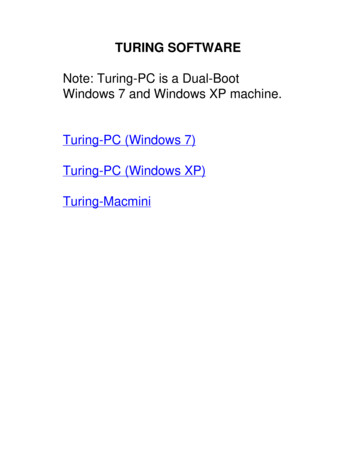
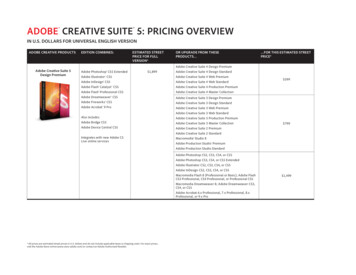
![Adobe Photoshop 2021 (Version 22.1.1) [32 64bit] [2022] - GWBC](/img/64/adobe-photoshop-2021-version-2211.jpg)
